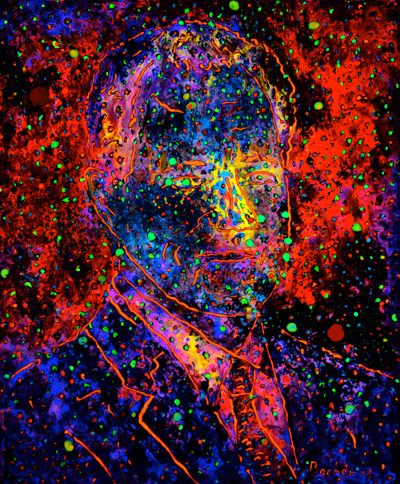Go for the Glow! | Luminescent Acrylic Paints and Tom Bacher

Using luminescent acrylic paints, Tom Bacher paints landscapes and portraits with spectacular lighting effects. He combines different brands of fluorescent and phosphorescent paints to achieve the look he wants for various elements in paintings that incorporate the elements of time and change, such as “New York City,” below.
New York City Painting

Learn more about The Artist’s Magazine’s 2013 July/August issue, where the full article about Bacher and his technique appears. http://www.northlightshop.com/artists-magazine/?lid=CMtamar050113
“I consider paintings that glow—that emit their own light—as new, just as Impressionism was new at one time,” says Tom Bacher. “I look at Impressionism as the art movement that captured the sun and daylight effects, while today, with luminous colors, it’s possible to capture the night effects because we’re looking at the paintings in the dark. I’ve been using luminous pigments exclusively for 38 years, and I’m still discovering new things.”
Scroll down to see two other photos of “New York City” taken at different time lapses as well as four photos of another painting, “Marc Nebula,” by Bacher. The artist created these two paintings using phosphorescent and fluorescent acrylic paints. He’s provided us with photos of how each looks in different lighting—how their appearance changes over time.
Luminous Paints | Fluorescent vs. Phosphorescent
Both fluorescent and phosphorescent paints become luminescent after exposure to light; they absorb and then emit the light. Fluorescent paints glow with the aid of a black light, whereas phosphorescent paints glow in a black light and on their own. Fluorescent paints emit light temporarily, while phosphorescent paints have a more noticeable, enduring luminescence.


“Marc Nebula” Painting
The painting “Marc Nebula” (fluorescent and phosphorescent paints, 24×18) is one of Bacher’s “Constellation” series that he is working on. Depending on the lighting, the painting can look more like a portrait, a constellation or a nebula!

Mixing the fluorescent red with the phosphorescent—glow-in-the-dark—paint creates a red that glows in the dark, even without a black light in the image below. Scroll down to view the other images.


- This image shows the “Marc Nebula painting after five minutes in the dark. The stars and linear drawing resemble constellation drawings.


- Here the “Marc Nebula” painting, in a black light, glows brightly as it’s lit by a black light.
Tom Bacher earned his bachelor of arts degree from the Art Academy of Cincinnati and his master of arts degree from Pratt Institute in Brooklyn, New York. His work appears in numerous museums and corporate and private collections nationwide and has been exhibited in Paris, Zurich, and Brussels. Bacher is represented by Cincinnati Art Galleries. Visit his website, www.tombacher.com.
You can download The Artist’s Magazine’s 2013 July/August digital issue here to learn more about Tom Bacher’s techniques.
Other Articles and Products You Might Find of Interest
Watch a preview of Chris Cozen’s video workshop Acrylic Painting: Color, Texture and Value. http://artistsnetwork.tv/p-479-acrylic-painting-color-texture-and-value-with-chris-cozen.aspx
Learn about Phillip M. Garrett’s book “Inside Acrylics: Studio Secrets from Today’s Top Artists.” http://artistsnetwork.tv/p-479-acrylic-painting-color-texture-and-value-with-chris-cozen.aspx?utm_source=cm&utm_medium=atv&utm_campaign=ar
MORE RESOURCES FOR ARTISTS
• Watch art workshops on demand at ArtistsNetwork.TV
• Get unlimited access to over 100 art instruction ebooks
• Online seminars for fine artists
• Learn how to paint & how to draw with downloads, books, videos & more from North Light Shop
• Subscribe to The Artist’s Magazine
• Sign up for your Artist’s Network email newsletter & download a FREE issue of The Artist’s Magazine





Have a technical question?
Contact UsJoin the Conversation!